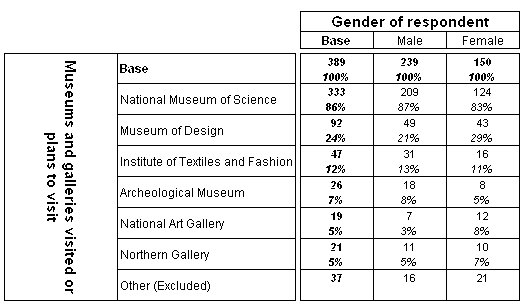Excluding categories from the base
This example is based on the Museum sample data set.
You can exclude particular categories from the calculation of the base, while still including the categories in rows or columns in the table. For example, you may want to include rows for “No Answer” or “Refused” responses in a table, while excluding these responses from the base, or from any calculations that use the base, such as percentages.
One way to do this is by setting the IncludeInBase property of the categorical element to False. This prevents the value for the category from being counted in the base, and automatically ensures that any summary statistics calculated from the base also exclude the category.
You can achieve this by entering the following into the top or side axis:
museums{..Northern_Gallery, Other 'Other (excluded)' [IncludeInBase=False]
The following table shows the results:
Table showing base element for museums variable, excluding value of Other category
Another way of excluding responses from a base is to create an expression for the base element. You can also use expressions to exclude responses from special elements such as mean or sample variance. For an example of how to add expressions to the base element, see “
Restricting a base using an expression.
For more information on how the
IncludeInBase property affects base elements, see
Excluding information from the base element.
See also

